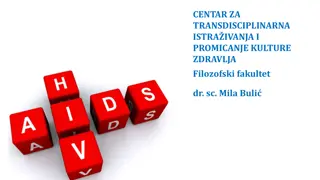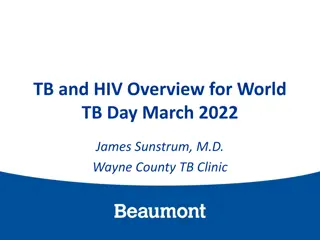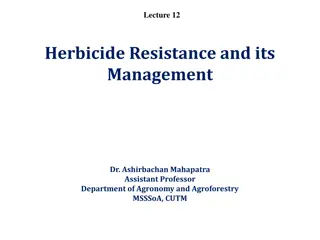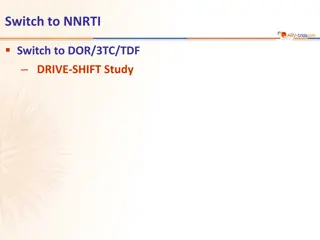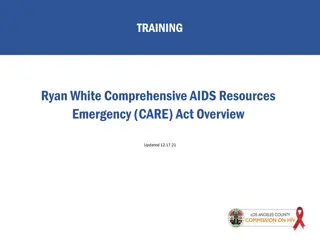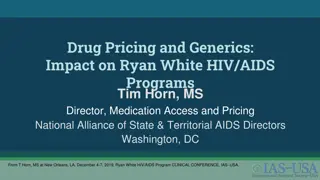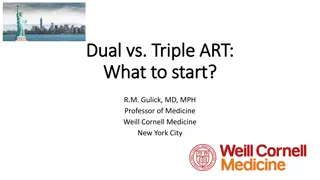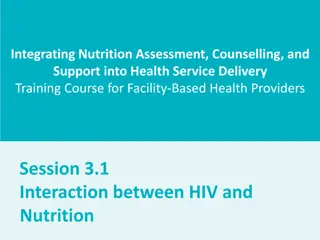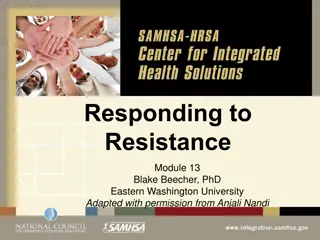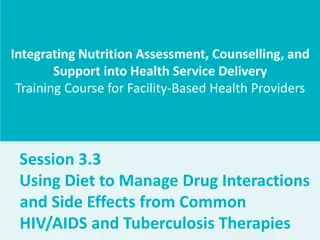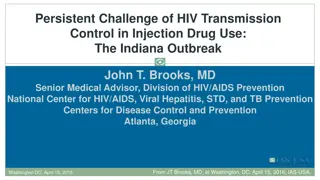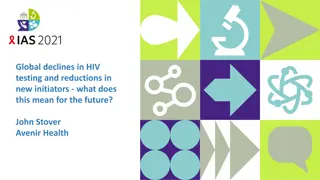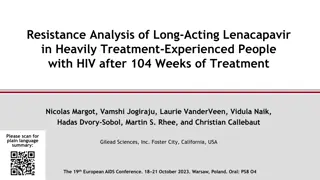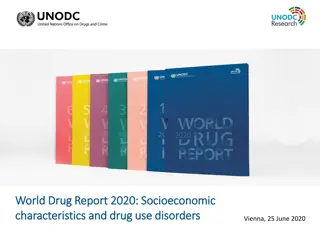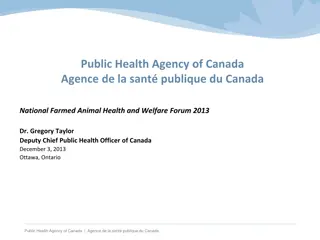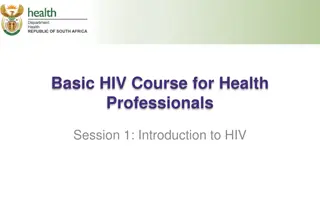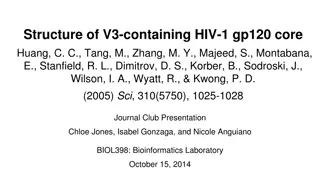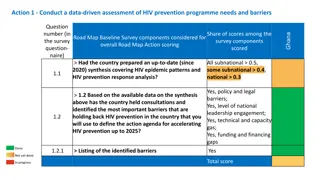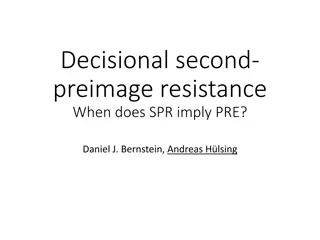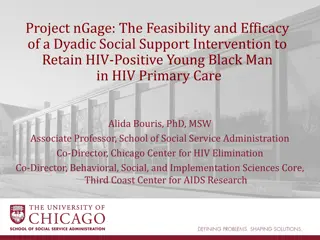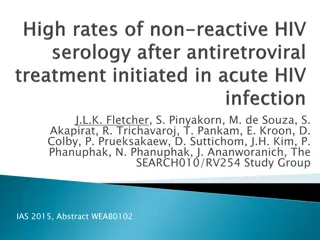HIV Drug Resistance in Health Professionals
Combination antiretroviral therapy (ART) is effective against HIV but can lead to drug resistance if not taken consistently. HIV mutates rapidly, increasing the risk of drug-resistant strains emerging. Learn about the causes, types of resistance, testing methods, and prevention strategies to combat drug resistance in HIV treatment.
Download Presentation

Please find below an Image/Link to download the presentation.
The content on the website is provided AS IS for your information and personal use only. It may not be sold, licensed, or shared on other websites without obtaining consent from the author.If you encounter any issues during the download, it is possible that the publisher has removed the file from their server.
You are allowed to download the files provided on this website for personal or commercial use, subject to the condition that they are used lawfully. All files are the property of their respective owners.
The content on the website is provided AS IS for your information and personal use only. It may not be sold, licensed, or shared on other websites without obtaining consent from the author.
E N D
Presentation Transcript
Basic HIV Course for Health Professionals Session 6b: Resistance
Learning Objectives By the end of this session participants should be able to: Explain drug resistance Explain how HIV drug resistances develops Differentiate between primary and secondary HIV drug resistance Explain causes of drug resistance Explain the types of resistance testing Explain prevention of drug resistance
Overview of Resistance Combination ART has proved to be very effective treatment for people with HIV as it: inhibits viral replication halts the progression of infection to AIDS allows for partial restoration of the immune system However, resistance can develop to any of the drug classes currently in use
Emergence of HIV Drug Resistance (1) In absence of ART, HIV copies itself very rapidly, with billions of new viruses every day Spontaneous mistakes occur, called mutations, which may allow virus to replicate even in the presence of ARVs When the virus continues to replicate (make more virus) even when a patient is taking treatment, there is treatment failure. This is to say that the treatment is failing to stop the virus from replicating. Furthermore, because people on ART have to take treatment for life, chances of emergence of drug resistant HIV increases over time
Emergence of HIV Drug Resistance (2) When HIV treatment is started, ARVs usually dramatically lowers amount of HIV in body, if: patient takes all drugs on time and virus is not already drug resistant If ARV regimen does not fully suppress viral replication, there will be selection for drug- resistant viruses that will continue replicating
Emergence of HIV Drug Resistance (3) If patient takes ART inconsistently, HIV is likely to make more copies of itself, and resistant viruses can proliferate, resulting in ARVs failing to block HIV replication and thus being ineffective
Drug Resistance Means virus is able to replicate/continue to grow, even when a person takes a medication that may usually work to keep the virus from multiplying Therefore, the medication no longer works
Types of Drug Resistance Primary (transmitted) Drug Resistance (TDR) It happens to a patient who is na ve and sometimes infected with a resistant virus Most common reason: patient infected by a partner (or mother) who has developed drug resistance secondary to ART Secondary (acquired) Drug Resistance Most common type of drug resistance Occurs when HIV continues to replicate in presence of ART Level of drugs are too low to block viral replication, but high enough to exert a positive selection pressure on virus
What are Some Causes of Resistance? Poor adherence Inadequate regimens resulting in insufficient drug level Drug supply issues
Factors Leading to Drug Resistance Many contributing factors lead to development of drug resistance Healthcare provider should: Identify potential barriers to lifelong ART adherence Provide patient education about importance of taking ARVs as prescribed Monitor patients closely for adherence at each visit Provide appropriate referrals if psychosocial challenges are identified
Factors Contributing to Development of HIV Drug Resistance: The Virus The extremely high rate of viral replication and lack of proofreading ability makes HIV particularly prone to the development of drug resistance
Genetic Barrier to Resistance and Potency It is easier for HIV to become resistant to some drugs compared to others It takes only one mutation to make the virus resistant to both NVP and EFV It also only takes one mutation to make the virus resistant to 3TC or FTC Two of the three drugs in current first-line regimens have a low genetic barrier to resistance It is harder for the virus to become resistant to ARVs that have a high genetic barrier to resistance DTG has a high genetic barrier to resistance so it is harder for the virus to become resistant to it 13
Factors Contributing to Development of HIV Drug Resistance: The Host (1) Most risk factors pertaining to host - due to adherence issues Adherence = extent to which patient follows prescribed treatment regimen In HIV treatment, adherence levels of above 90% are needed to prevent drug resistance
Factors Contributing to Development of HIV Drug Resistance: The Host (2) Factors affecting adherence: Demographic characteristics Psychosocial/ behavioural characteristics Health care administration and delivery characteristics Medication characteristics
Factors Contributing to Development of HIV Drug Resistance: The Treatment Poor potency Wrong dose Drug-drug interactions
Testing for HIV Drug Resistance Two ways to test for HIV drug resistance: Phenotypic testing: Standard way to test for antimicrobial drug resistance Genotypic testing: Based on PCR technology; detects presence of mutations in a virus population
Preventing HIV Drug Resistance (1) The WHO Global Action Plan on HIV Drug Resistance (2017-2021) recommends two main strategies to reduce risk of emergence of HIV drug resistance, namely: Prevention of HIV drug resistance and Monitoring and Surveillance of HIV drug resistance
Preventing HIV Drug Resistance (2) Optimization of ART service delivery Implementation of test and treat Quality programmes should ensure: Adequate adherence support for all patients on treatment Appropriate use of ARV drugs Strategies to maximize retention in care, limit loss to follow-up Continuous supply of ARVs Viral load testing Identification of individuals failing first-line ART HIV Drug Resistance testing for individuals failing second- line ART
Preventing HIV Drug Resistance (3) Assess quality of HIV treatment service delivery in all ART clinics using existing monitoring and evaluation systems and national indicators - early warning indicators (EWIs) of HIV Drug Resistance Done annually using routinely collected patient data
Preventing HIV Drug Resistance (4) EWIs of HIV Drug Resistance and quality of care include: On-time pill pick-up Retention on ART at 12 months Drug stock-outs Viral load testing monitoring Viral load suppression Appropriate switch to second-line ART
Preventing HIV Drug Resistance (5) EWI indicators directly speak to concerns about HIV drug resistance and they help to: provide clinic information which gives opportunities for corrective action to improve quality of care serve as an alert on possible emergence of drug resistance identify clinics that can serve as best practice models Use of EWIs should never be punitive but should be used as a basis for action Finally, quality data on HIVDR should be collected through periodic HIV drug resistance surveys to monitor risk of emergence of HIV drug resistance so action can be taken
Any Questions? Thank you!


